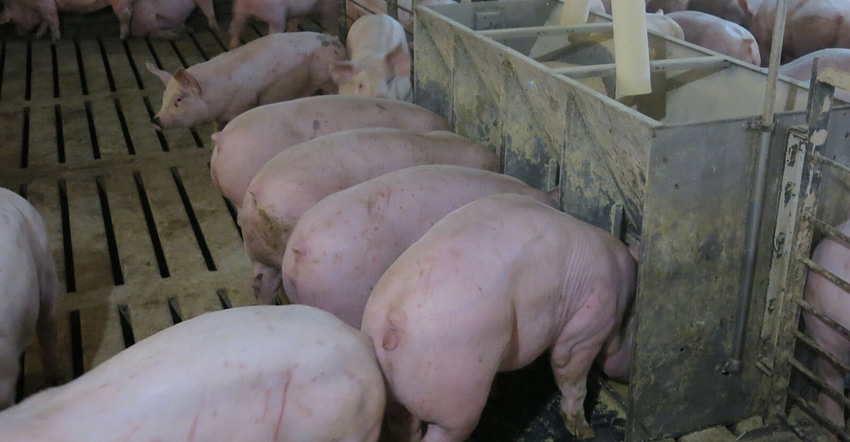The industry is intent on challenging demand. Certainly if the trade dispute can be resolved, the United States is the most efficient and reliable producer of high-quality pork in the world.
September 30, 2019

The data from the September quarterly Hogs and Pig Report (released Friday) confirm that the industry continues to expand their breeding herd and the industry continues to achieve a record high pigs per litter. The data measured the inventory of all hogs and pigs on Sept. 1 at 77.67 million, or 103% of last year. Kept-for-breeding inventory was pegged at 6.43 million sows, or 102% of last year, and the kept-for-market category was measured at 71.24 million, or 104% of last year.
The industry farrowed 1% fewer sows in the June-August timeframe but with another record high pigs per litter, the pig crop, at 35.30 million, was up 3% from the summer of last year. Looking ahead, the September-November farrowing intentions were estimated to be down 1% from the same period last year with the December-February intentions projected to be even with last year.
This report, evidently, confirms that profits have been good enough in the industry to keep expansion continuing. The report confirms that production next year will surpass production this year and, of course, remain record large. In tandem with record large poultry production and record large beef production, the demand side of the marketplace has a major job to do or widespread losses in the industry will develop. The marketplace has never had this level of protein to clear. If any hiccups occur on the demand side of the ledger, widespread losses will occur.
The prospects for U.S. pork demand look good. African swine fever continues to spread in Asia. Not only is this disease still spreading and causing major problems in China and Vietnam, but over the last month ASF has been confirmed again in Russia, in the Philippines and most recently in South Korea. My sources indicate that South Korea will likely not have much more success at containing this disease than has China and Vietnam.
Focusing on China, the government has recently reported that ASF has decimated close to 40% of their breeding stock. This is a disaster of unprecedented magnitude and it’s not over yet. In fact, it may not even be close to being over. With ASF all over Asia, containment and control will likely take years to achieve.
Chinese authorities are still trying to down play the impact of ASF. Private sources estimate losses of breeding stock of over 50%. Eventually, up to 80% of the Chinese breeding herd may be lost. Hog prices and pork prices in China have soared to record high levels. The situation is so serious that one of the four vice premiers has been charged with specific responsibilities for overseeing government efforts to control pork prices and to increase pork supplies. In other words, this is a top priority for the Chinese government.
The vice premier has stated he’s implementing three policies to control the price of pork. First, expanding pork production and capacity. Second, increasing imports, and third releasing pork from the reserves. The first policy, expanding production and capacity will be nearly impossible until the spread of ASF is under control. As of this writing there is absolutely no evidence to suggest the spread is under control. So, this leaves increasing imports and releasing pork from the reserves.
Pork has been released from the reserves two different times recently. Each release amounted to 10,000 metric tons of pork, or less than two days worth of consumption. A drop in the bucket. The amount of pork in the Chinese reserve is unknown. However, the government can purchase U.S. pork for placement into the reserve without paying the tariff. This is likely to happen, perhaps in very large quantities while the trade dispute continues.
Data confirm that Chinese pork imports have soared this year. The data also confirm that the European Union is getting the lion’s share of the business. In the face of higher Chinese imports during the January through July period, the EU captured 62% of the imports compared to only 9% for the U.S. pork producer. Canada captured 15% of the Chinese imports with Brazil getting 10%. So, the trade war and the resulting 60% Chinese tariff on U.S. pork is stifling U.S. export business. Still, despite this fact, U.S. pork exports to China in July were 380% of the prior year.
So, the trade war continues to hamper the U.S. pork trade with China. The next round of talks is scheduled for Oct. 10-11 when Chinese officials will travel to the United States. It appears that both the United States and China are eager to find some common ground. A complete and total resolution to the trade dispute at this meeting is highly unlikely. However, some sort of rollback of tariffs on both sides may be agreed to in an effort to claim victory on both sides.
The industry is intent on challenging demand. Certainly if the trade dispute can be resolved, the United States is the most efficient and reliable producer of high-quality pork in the world. As these issues are hammered out, the key, of course, is for the United States to remain disease-free.
Source: Dennis Smith, who is solely responsible for the information provided, and wholly owns the information. Informa Business Media and all its subsidiaries are not responsible for any of the content contained in this information asset.
About the Author(s)
You May Also Like





